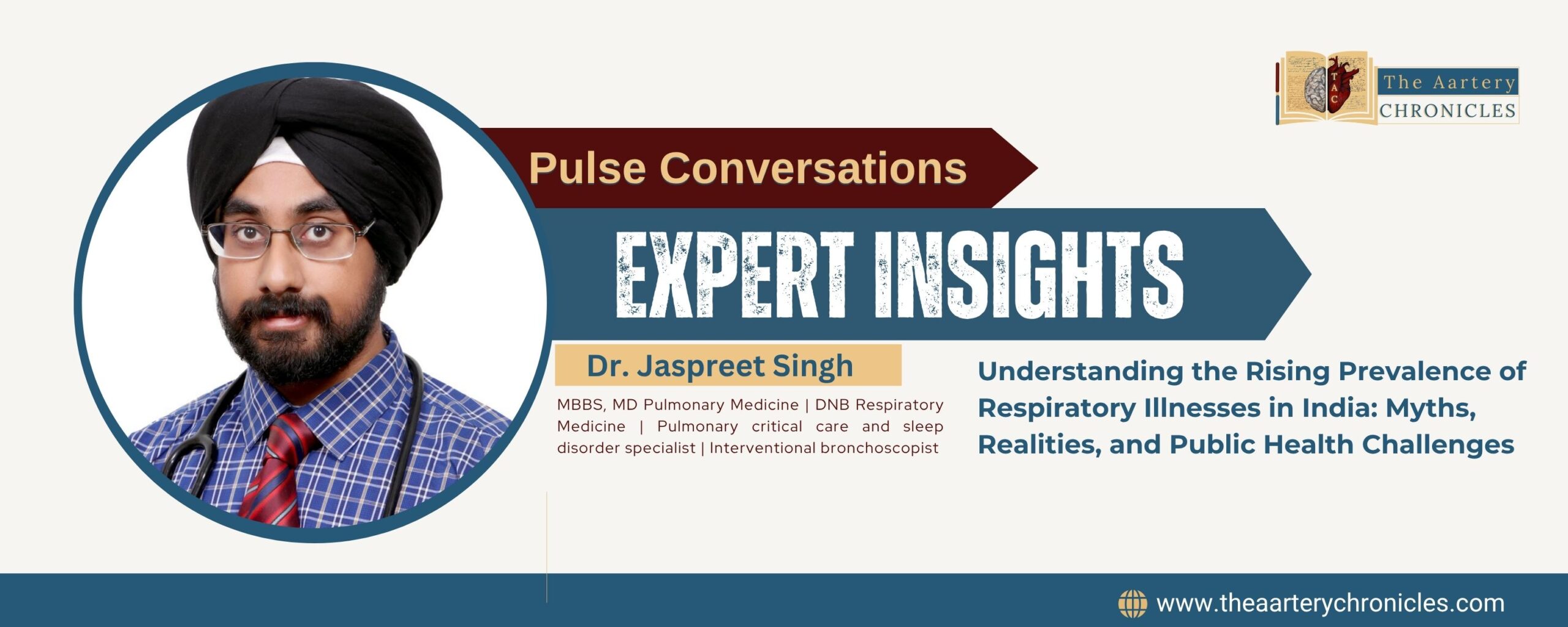

Understanding the Rising Prevalence of Respiratory Illnesses in India: Myths, Realities, and Public Health Challenges
Overview
Pneumonia and other respiratory illnesses are on the rise in India, posing a growing threat to public health. While environmental factors such as pollution are well-known contributors, misconceptions about cold weather and poor preventive practices also play a significant role in how these illnesses spread and are managed.
In an in-depth conversation with The Aartery Chronicles, Dr. Jaspreet Singh Khandpur, an experienced interventional pulmonologist and chest physician, offers critical insights into the prevalence of lung diseases in India, debunks common cold-weather myths, and emphasizes the urgent need for greater public awareness and behavioral change in healthcare.
Dr. Jaspreet Singh Khandpur’s expertise is widely sought after, particularly for high-risk cases that require advanced diagnostic and therapeutic interventions. He is currently attached to several prominent hospitals in the Thane and Navi Mumbai areas, such as Titan Medicity, Kasargodavli, Horizon Prime Hospital, Reliance Hospital, Coper Clinic, and Highline Hospital. Other hospitals he is associated with include Curie and Bethany Hospitals, among others. In addition to his hospital affiliations, Dr. Singh runs his own clinic in Kolshetraur, DMAT, where he specializes in bronchoscopies, thoracoscopies, and foreign body removals.
Environmental and Social Drivers of Respiratory Illness
Air Quality: A Key Contributor
One of the most pressing issues is the deteriorating air quality. Cities across India are experiencing dangerously high pollution levels. As Dr. Singh notes, this is not just observable through air quality index (AQI) readings—it’s visible to the naked eye. What used to be fog in the mornings is now more often smoke, even in smaller cities. Industrial emissions, particularly in areas like Navi Mumbai, can travel with the wind and affect neighboring regions like Thane, spreading pollutants far beyond their source.
This pollution doesn’t stay confined to one city. It circulates, creating a chain reaction of respiratory risks in multiple urban and semi-urban areas. Densely populated regions, in particular, are more vulnerable to outbreaks of pneumonia and other lung infections.
The Role of Hygiene and Public Behavior
Another critical factor contributing to the rise in respiratory illnesses is personal hygiene and public behavior. While medical professionals adopt preventive measures such as hand sanitizing and masking, these habits are not consistently practiced by the general population. Dr. Singh notes that precaution in India is often reactionary—people begin taking health measures only after an outbreak occurs, unlike in some countries where preventive habits are routine.
For instance, countries like South Korea act early, while others like the US or UK may delay. In India, precaution is typically triggered only after the situation worsens.
Cultural Practices and Gatherings
Large public gatherings, such as religious festivals and community events, are also hotspots for disease transmission. In crowded spaces, the risk of respiratory infections increases significantly, especially when masks are not worn and hygiene is not maintained.
Geographic Differences in Prevalence
Interestingly, hilly regions see lower overall prevalence of respiratory illnesses, largely due to cleaner air. However, indoor pollution from stoves, wood smoke, and cigarette use still poses a serious risk, especially for women and elderly individuals involved in daily cooking.
On the other hand, rural and semi-urban areas face rising threats from chemical exposure, lack of sanitation, and industrial emissions.
Myths, Medical Realities, and Health Challenges
Is Cold Weather to Blame for Pneumonia?
Dr. Singh explains that cold weather does not directly lead to pneumonia or lung infections. The popular belief that drinking cold water causes coughing or leads to pneumonia is misleading. What actually happens is that cold water or cold air may trigger lung spasms, especially in individuals with underlying respiratory conditions such as bronchitis or asthma. These spasms can lead to symptoms like coughing or chest tightness, but they are not the same as pneumonia.
“In India, we often associate any winter-related cough or breathing issue with pneumonia,” explains Dr. Singh. “But many of these cases are actually cold-induced bronchitis or allergic reactions—not bacterial infections.”
Reality: Comorbidities and Pollution Are Key Risks
India is quickly emerging as the global hub for diabetes, which carries serious health consequences. One major concern is that diabetes greatly heightens the risk of infections such as pneumonia. The real contributors to pneumonia include weakened immune defenses, exposure to polluted air, smoking, and chronic conditions like diabetes. India’s rapidly increasing diabetes rates—along with widespread tobacco use—significantly raise the risk of severe lung infections
When Cold Weather Becomes a Real Risk
While cold itself doesn’t cause pneumonia, it can exacerbate existing health conditions and lower immunity. People with asthma, bronchitis, diabetes, or elderly individuals are more likely to develop pneumonia during winter months because their immune systems are already compromised.
If these patients experience persistent cough, especially with fever or phlegm, it could be more than just seasonal bronchitis. “In such cases, using mucolytics (medications that thin mucus), steam inhalation, and antihistamines can help prevent the infection from progressing into pneumonia,” Dr. Singh advises.
Breaking the Stigma Around Inhalers and Nebulizers
Dr. Singh also highlights a significant cultural barrier in India: the stigma attached to inhalers and nebulizers. Many people avoid using them out of fear that they are habit-forming. However, he clarifies that these tools are essential medical aids for those who truly need them.
“Inhalers are not a habit; they’re a necessity,” he stresses. “Carrying an inhaler on a trip to a cold place can prevent severe bronchial attacks. It’s wiser to take preventive steps and seek timely care than to endure illness and risk complications by delaying treatment.
Healthcare Challenges: Overuse of Antibiotics and Drug Resistance
Dr. Singh cautions against the overuse of antibiotics, especially in cases where the symptoms are caused by viral infections. He explains that yellow phlegm or high fever is not always a sign of bacterial infection. Often, antiviral medication or supportive care is more appropriate. The widespread misuse of antibiotics contributes to antibiotic resistance, making it increasingly difficult to treat bacterial infections effectively in the future.
“In some cases, we’re left with using outdated drugs because current strains of pneumonia have become resistant,” Dr. Singh warns. “These resistant strains pose a greater threat and are much harder to treat effectively.”
The situation is especially concerning in hospital settings, where hospital-acquired infections (HAIs) can occur in immunocompromised patients. These are not due to hospital negligence but rather a result of weakened immunity and prior antibiotic overuse.
Dr. Singh emphasizes that hospitals are not to blame for these infections. “When the immune system is weak, even the smallest lapse in hygiene—by the patient or visitors—can introduce infections.
Conclusion: Prevention Begins with Awareness
The surge in respiratory illnesses in India goes beyond a medical issue—it’s a pressing public health crisis. Myths surrounding cold weather, inhaler use, and pneumonia must be dispelled through consistent education and outreach. Dr. Singh strongly advocates for:
- Using prescribed inhalers or nebulizers without stigma
- Avoiding unnecessary antibiotic use
- Taking extra care during cold seasons if you have underlying health issues
- Maintaining personal hygiene, especially in crowded or hospital environments
- Recognizing that not every cough or fever is pneumonia
Ultimately, respiratory illnesses like pneumonia are complex and multifaceted. They are driven not by cold weather alone, but by a combination of environmental pollution, behavioral gaps, healthcare mismanagement, and rising comorbidities. A more informed, proactive approach is essential to reducing their impact and protecting public health in India.









